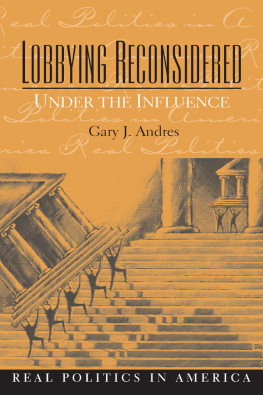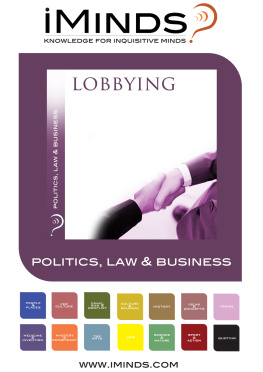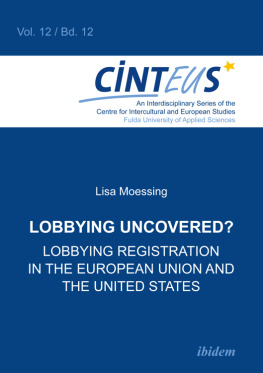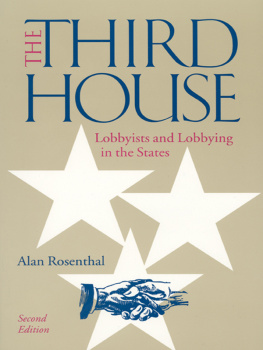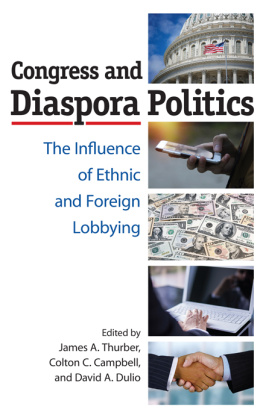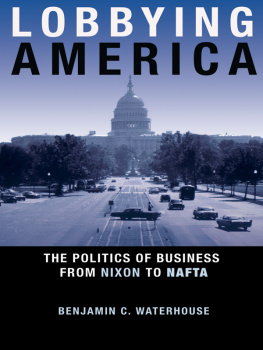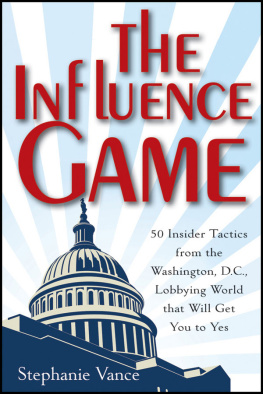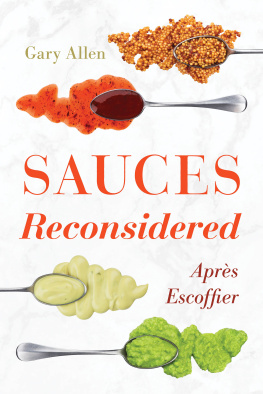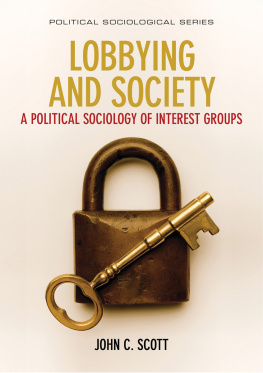LOBBYING
RECONSIDERED
REAL POLITICS IN AMERICA
Series Editor: Paul S. Herrnson, University of Maryland
The books in this series bridge the gap between academic scholarship and the popular demand for knowledge about politics. They illustrate empirically supported generalization from original research and the academic literature using examples taken from the legislative process, executive branch decision making, court rulings, lobbying efforts, election campaigns, political movements, and other areas of American politics. The goal of the series is to convey the best contemporary political science research has to offer in ways that will engage individuals who want to know about real politics in America.
Series Editorial Board
Scott Adler, University of Colorado
Christine L. Day, University of New Orleans
Kenneth M. Goldstein, University of Wisconsin-Madison
Rodney Hero, University of Notre Dame
Karen OConnor, American University
Kelly D. Patterson, Brigham Young University
John J. Pitney, Jr., Claremont McKenna College
Darrell M. West, Brown University
Clyde Wilcox, Georgetown University
First published 2009 by Pearson Education, Inc.
Published 2016 by Routledge
2 Park Square, Milton Park, Abingdon, Oxon OX14 4RN
711 Third Avenue, New York, NY 10017, USA
Routledge is an imprint of the Taylor & Francis Group, an informa business
Copyright 2009 Taylor & Francis. All rights reserved.
All rights reserved. No part of this book may be reprinted or reproduced or utilised in any form or by any electronic, mechanical, or other means, now known or hereafter invented, including photocopying and recording, or in any information storage or retrieval system, without permission in writing from the publishers.
Notice:
Product or corporate names may be trademarks or registered trademarks, and are used only for identification and explanation without intent to infringe.
For permission to use copyrighted material, grateful acknowledgment is made to the copyright holders on pp. 61, 79, 122, 123, 132, 133, 145, and 173 which are hereby made part of this copyright page.
ISBN: 9780136032656 (pbk)
Library of Congress Cataloging-in-Publication Data
Andres, Gary J.
Lobbying reconsidered : under the influence / Gary J. Andres.1st ed.
p. cm.
Includes bibliographical references and index.
ISBN 0-13-603265-6 (alk. paper)
1. LobbyingUnited States. 2. United StatesPolitics and government2001 I. Title.
JK1118.A66 2009
328.73'078dc22
2008019452
After the election in 2000, the transition team of then President-elect George W. Bush assembled a small group of veteran lobbyists to help map out Senate confirmation strategies for the new cabinet. Experienced former legislative liaison personnel from the Nixon, Ford, Reagan, and George H.W. Bush White House staffs populated this team of knowledgeable advocates. Internally, they were known as the Sherpas, each one guiding the nomination of a soon-to-be cabinet member through the often-treacherous Himalayas of approval by the U.S. Senate.
I was part of that cadre of confirmation guides, and the experience taught me a lot about the process of advocacy in Washington. It revealed that lobbying involves a lot more than just relationships, friends, access, favors, and influencethe dialect most speak when describing interest-group power. Instead, the process was much more complex. As one former White House aide once said, the real world of advocacy is like the difference between checkers and three-dimensional chess. My other jobs all taught me similar lessons, while serving on the White House staff, as a congressional staffer, as a lobbyist with a corporation, and in my current role overseeing research and policy at a global public affairs firm.
These experiences convinced me that extant writing about the world of interest groups and their advocates is not necessarily wrong; it's just too narrow. The common notion of lobbyist as influence peddler struck me both as cynical and incomplete.
Lobbying Reconsidered: Under the Influence offers a broader perspective on this important dimension of American public policymaking. In the preface of his book, an undergraduate professor of mine, Leland Ryken of Wheaton College in Illinois, describes himself as a travel guide, helping students navigate the unfamiliar world of verse. In a similar vein, and invoking my background as a Sherpa, I hope to use my experience and insights in the lobbying world to help you navigate beyond the conventional wisdom, and guide you to a deeper, broader understanding.
Lobbying is now a big business in Washington, with many more dimensions than during the 1960s and 1970s. It is larger, more structurally complex, and tactically varied than suggested by the soft stereotype of Gucci loafers. It's also a dynamic enterprise, very different today than even a few short years ago.
Working in and around the lobbying industry for the past quarter of a century, I've seen a lot of how this world worksthe good, the bad, and the ugly. I've also read a lot of journalist and academic musings about lobbyists some of it good, but also, frankly, much of it bad and ugly. After reading this book, students and scholars alike should have a much better understanding of the role of lobbyists and interest groups in the American system, including the tools that produce successful influence and those that don't. It will also demonstrate the limits of lobbying and why money or other resources don't always translate to political power or influence. And finally, that much of what lobbyists do, and how and why they do it, is not lobbying at all. Probing a little deeper into the real behaviors, motivations, and tactics of the new advocacy world will help debunk many myths and improve public understanding.
I owe a debt of gratitude to many who helped inspire and shape this volume. Five political scientists read the entire manuscript and provided keen insights, perspective, and constructive criticism. For their time, thoughtful critiques, and feedback I thank Barry Rundquist, Bird Loomis, Paul Herrnson, James Gimpel, and Jim Thurber.
My friends in the lobbying business also shaped this volume. I want to thank Pat Griffin, Bert Carp, Bob Russbuldt, and Nick Franklin, who also read and commented on the entire book. Others like Bruce Gates, Tim McKone, Greg Crist, Steve Perry, Ron Kaufman, Marybeth Kerrigan, Kim Bayliss, and Sarah Levin read individual chapters and/or agreed to let me attribute their observations and insights by name. I also am indebted to the entire family at Dutko Worldwidetoo many to mention by namefor their support, friendship, and lessons they have taught me over the years. And a special thanks to my other partners at the firm not mentioned above, Mark Irion, Arthur Silverman, Craig Pattee, Darren Willcox, Brad Card, David Beightol, Bill Simmons, Sally Painter, and Karen Tramontano for their friendship and support.
Two of my Dutko colleagues deserve special credit. First, I want to thank Brandon Smith, who helped compile charts, conducted some of the research, and generally organized the manuscript development. Second, I owe a very special debt of gratitude to Lauren Lawson, who literally read the entire manuscript at least three times. Her careful eye and disciplined editing greatly improved this book. Any remaining errors or omissions are, of course, my own.


